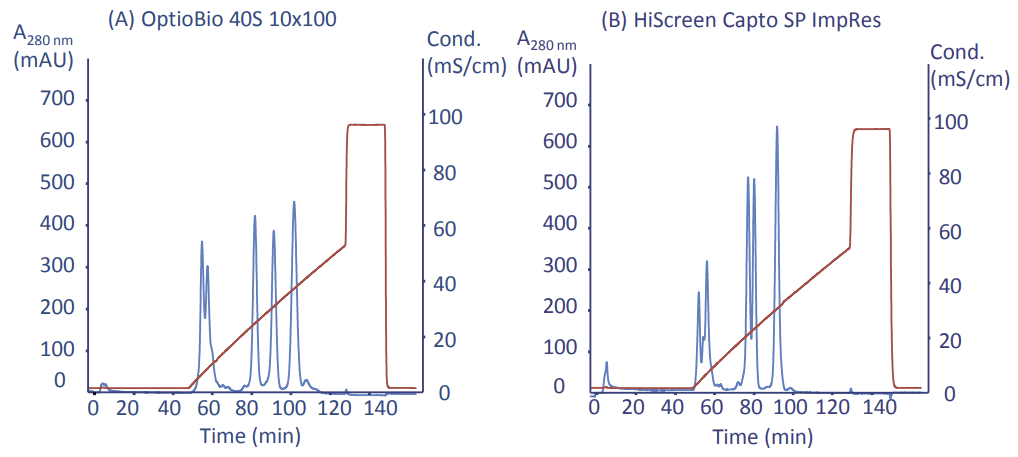Introduction
The prepacked OptioBio™ glass columns are designed for small-scale purification as well as screening and optimization in bioprocess development and scale-up. These columns have a column volume of 7.9 ml with 10-mm i.d. and 100-mm bed height (Fig 1).
OptioBio 40S 10x100 and OptioBio 40Q 10x100 columns are prepacked with WorkBeads™ 40S and WorkBeads 40Q resins for ion exchange chromatography (IEX). The resins are designed for research and industrial scale purification of proteins, peptides and nucleic acids, and utilise the difference in these molecules surface charge.
WorkBeads 40S is a strong cation exchange resin with sulfonate ligands, and WorkBeads 40Q a strong anion exchange resin with quaternary amine ligands (Fig 2).
The resins allow high-resolution separation in combination with low backpressure which make them excellent for both capture and polishing purification applications.
-1.webp?width=828&height=419&name=f1%20(1)-1.webp)
Figure 1. OptioBio 40S 10x100 and OptioBio 40Q 10x100 prepacked columns.
.webp?width=853&height=194&name=f2%20(1).webp)
Figure 2. Structure of the ligand used in WorkBeads 40S (A) and WorkBeads 40Q (B).
Dynamic binding capacity (DBC)
The DBC using bovine serum albumin (BSA) of the prepacked OptioBio columns were compared with the HiScreen™ IEX columns from GE Healthcare (Fig 3). The same conditions were applied for comparable columns.
.webp?width=811&height=595&name=f3%20(1).webp)
Figure 3. Comparison of dynamic binding capacity. DBC measured at 10% breakthrough (QB10%). (A) 2 mg BSA/ml in 20 mM Na-citrate, pH 4.0. Flow rate 150 cm/h. (B) 1 mg BSA/ml in 50 mM Tris-HCl, 50 mM NaCl, pH 8.0. Flow rate 150 cm/h.
Resolution
The resolution of the prepacked OptioBio columns were compared with the HiScreen IEX columns from GE Healthcare (Fig 4 and Fig 5). A protein mixture was separated under the same conditions for the comparable columns, and with the same sample load per ml resin and linear flow rate.
Sample: 1.5 mg/ml concanavalin A,
0.5 mg/ml α-chymotrypsinogen A,
1.5 mg/ml ribonuclease A, 0.5 mg/ml lysozyme
in binding buffer
Sample volume: 2.5 ml (OptioBio 40S 10x100)
1.5 ml (HiScreen Capto SP ImpRes)
Binding buffer: 50 mM MES, pH 6.0
Elution buffer: 50 mM MES, 1 M NaCl, pH 6.0
Linear gradient: 0 - 50% in 20 column volumes (CV)
Flow rate: 150 cm/h, 4 minutes residence time
2.0 ml/min (OptioBio 40S 10x100)
1.2 ml/min (HiScreen Capto SP ImpRes)

Figure 4. Resolution comparison on OptioBio 40S 10x100 (A) vs. HiScreen Capto SP ImpRes (B).
Sample: 0.7 mg/ml apo-transferrin, 0.45 mg/ml α-lactalbumin,
1.4 mg/ml soybean trypsin inhibitor in binding buffer
Sample volume: 10 ml (OptioBio 40Q 10x100)
6 ml (HiScreen Capto Q ImpRes)
Binding buffer: 50 mM Tris-HCl, pH 7.4
Elution buffer: 50 mM Tris-HCl, 1 M NaCl, pH 7.4
Linear gradient: 0 - 40% in 20 CV
Flow rate: 150 cm/h, 4 minutes residence time
2.0 ml/min (OptioBio 40Q 10x100)
1.2 ml/min (HiScreen Capto Q ImpRes)

Figure 5. Resolution comparison on OptioBio 40Q 10x100 (A) vs. HiScreen Capto Q ImpRes (B).
Conclusions
OptioBio 40S 10x100 and OptioBio 40Q 10x100 prepacked columns gave more than 30% higher dynamic binding capacity compared with HiScreen Capto SP and HiScreen Capto Q ImpRes, respectively.
OptioBio 40S 10x100 showed significantly higher selectivity and improved resolution for several of the proteins compared to HiScreen Capto SP ImpRes. OptioBio 40Q 10x100 showed equal resolution as HiScreen Capto Q ImpRes.
HiScreen and Capto are trademarks of General Electric Company.
Purification made simple
PS55410011 AA